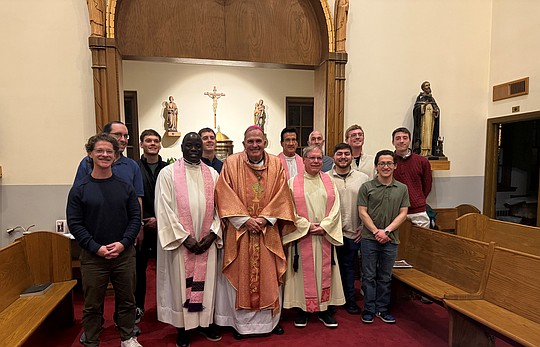Truth in a haunting equation
July 29, 2019 at 12:37 p.m.
In her novel, Final Payments, Mary Gordon articulates an equation that has long influenced Christian spirituality, both for good and for bad.
Her heroine, Isabel, is a young woman within whom a strong Catholic background, an overly-strict father, and a natural depth of soul conspire together to leave her overly-reticent and overly-reflective, looking at life from the outside, too self-aware and too reflective in general to enter spontaneously into a dance or trust any kind of gaiety
One night she goes to a party of college students but almost immediately feels out of place inside the giddiness, youthful bravado, drinking, and dancing. So she falls back into an old habit: “I would look among the faces of the students for a face that I could love. I would look for something original, something attesting in the shape of the chin or the eyes, something that suggested the belief that there was residual pain that could not be touched by legislation. But they all looked so relentlessly happy and healthy that they did not interest me. I realized that I was looking for someone who was sad, and I was angry at myself for making the equation, my father’s equation, the Church’s equation, between suffering and value.”
That equation between suffering and value has a long-standing history within spirituality and has strongly influenced us both positively and negatively. It has also, I must confess, generally been my own equation. Like Mary Gordon’s Isabel, I too tend to look around the room at a party for a sad face, with the belief that sadness is a sign of depth, of substance, of weightiness. Occasionally I have been right and a face carrying sadness did indeed issue forth from a deep interiority, but I have also often been wrong. Sometimes that sadness is merely an indication of depression, timidity, and unacknowledged anger. As well, I have also met people who were strongly extroverted in manifesting their happiness and joy and who, underneath, had real depth of soul and were anything but superficial.
But still the equation haunts me, as it has haunted Christian spirituality throughout the centuries. We have perennially tended to equate suffering and sadness with value and depth. I remember my Novice Master challenging us with the notion that there is no recorded incident in Scripture of Jesus laughing; the idea being that all of Jesus’ depth took its root inside his suffering. Laughter and lightness of heart are to be seen as superficial. That helped reinforce a notion that was deeply branded into me as a child, growing up in an immigrant Catholic family and community. We were virtually catechized with the expression: After the laughter, come the tears! The idea was clear: Laughter is superficial and ultimately only an attempt to keep reality and sadness at bay. Sadness is what’s real, so don’t be too taken in by partying and laughing it up.
What’s to be said about all of this? Clearly, there is truth in the equation. Any good psychologist, spiritual director, or mentor of soul, will tell you that, most often, real growth and maturity of soul are triggered by deep suffering and pain in our lives. It’s not so much that God doesn’t speak as clearly to us in our joys and successes, but we tend not to be listening in those moments. Suffering gets our attention. As C.S. Lewis once said, pain is God’s microphone to a deaf world. There is, undeniably, a connection between suffering and depth of soul.
But we must be careful not to read too much into this. When we look at Jesus, and many other wonderfully healthy people, we see that depth of soul is also connected to the joyous and celebratory moments of life. Jesus scandalized people equally in both his capacity to enter into suffering and renounce worldly joys and in his capacity to thoroughly enjoy the moment, as is evident in the incident where a woman anoints his feet with a very expensive perfume. His depth of soul arose both from his suffering and from his joy. And his gratitude, I suspect, arose more out of the latter than the former.
Oblate Father Ron Rolheiser, theologian, teacher, and award-winning author, is President of the Oblate School of Theology in San Antonio, TX. He can be contacted through his website www.ronrolheiser.com.
[[In-content Ad]]Related Stories
Sunday, December 14, 2025
E-Editions
Events
In her novel, Final Payments, Mary Gordon articulates an equation that has long influenced Christian spirituality, both for good and for bad.
Her heroine, Isabel, is a young woman within whom a strong Catholic background, an overly-strict father, and a natural depth of soul conspire together to leave her overly-reticent and overly-reflective, looking at life from the outside, too self-aware and too reflective in general to enter spontaneously into a dance or trust any kind of gaiety
One night she goes to a party of college students but almost immediately feels out of place inside the giddiness, youthful bravado, drinking, and dancing. So she falls back into an old habit: “I would look among the faces of the students for a face that I could love. I would look for something original, something attesting in the shape of the chin or the eyes, something that suggested the belief that there was residual pain that could not be touched by legislation. But they all looked so relentlessly happy and healthy that they did not interest me. I realized that I was looking for someone who was sad, and I was angry at myself for making the equation, my father’s equation, the Church’s equation, between suffering and value.”
That equation between suffering and value has a long-standing history within spirituality and has strongly influenced us both positively and negatively. It has also, I must confess, generally been my own equation. Like Mary Gordon’s Isabel, I too tend to look around the room at a party for a sad face, with the belief that sadness is a sign of depth, of substance, of weightiness. Occasionally I have been right and a face carrying sadness did indeed issue forth from a deep interiority, but I have also often been wrong. Sometimes that sadness is merely an indication of depression, timidity, and unacknowledged anger. As well, I have also met people who were strongly extroverted in manifesting their happiness and joy and who, underneath, had real depth of soul and were anything but superficial.
But still the equation haunts me, as it has haunted Christian spirituality throughout the centuries. We have perennially tended to equate suffering and sadness with value and depth. I remember my Novice Master challenging us with the notion that there is no recorded incident in Scripture of Jesus laughing; the idea being that all of Jesus’ depth took its root inside his suffering. Laughter and lightness of heart are to be seen as superficial. That helped reinforce a notion that was deeply branded into me as a child, growing up in an immigrant Catholic family and community. We were virtually catechized with the expression: After the laughter, come the tears! The idea was clear: Laughter is superficial and ultimately only an attempt to keep reality and sadness at bay. Sadness is what’s real, so don’t be too taken in by partying and laughing it up.
What’s to be said about all of this? Clearly, there is truth in the equation. Any good psychologist, spiritual director, or mentor of soul, will tell you that, most often, real growth and maturity of soul are triggered by deep suffering and pain in our lives. It’s not so much that God doesn’t speak as clearly to us in our joys and successes, but we tend not to be listening in those moments. Suffering gets our attention. As C.S. Lewis once said, pain is God’s microphone to a deaf world. There is, undeniably, a connection between suffering and depth of soul.
But we must be careful not to read too much into this. When we look at Jesus, and many other wonderfully healthy people, we see that depth of soul is also connected to the joyous and celebratory moments of life. Jesus scandalized people equally in both his capacity to enter into suffering and renounce worldly joys and in his capacity to thoroughly enjoy the moment, as is evident in the incident where a woman anoints his feet with a very expensive perfume. His depth of soul arose both from his suffering and from his joy. And his gratitude, I suspect, arose more out of the latter than the former.
Oblate Father Ron Rolheiser, theologian, teacher, and award-winning author, is President of the Oblate School of Theology in San Antonio, TX. He can be contacted through his website www.ronrolheiser.com.
[[In-content Ad]]









